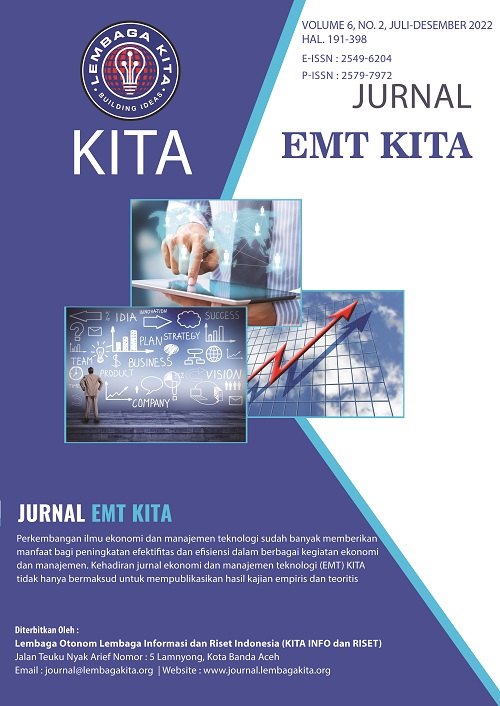Analisis Dampak Pengembangan Pariwisata Terhadap Perekonomian Masyarakat Lokal di Era New Normal
DOI:
https://doi.org/10.35870/emt.v6i2.723Keywords:
Tourism, Economy, New Normal EraAbstract
Tourism is able to raise the level of the economy, but reflecting it on the Covid-19 pandemic, and its transition to the New Normal Era continues to be debated. Thus, this study aims to analyze the impact of tourism development on the economy of local communities in the new normal era. This study uses a phenomenological qualitative method. The sample came from the people of Tidung Island, the sample was selected using a purposive sampling technique. Collecting data with interview instruments, focus group discussions, document studies, and observation. Check the validity and reliability of the data using triangulation techniques. The data analysis is Interactive Model Analysis. The results show that the implications of new normal era tourism development are confirmed to have a positive impact on the economy and welfare of local communities.
Downloads
References
Alimudin, M., & Dharmawati, D. M. (2022). Strategi Komunikasi Pemasaran Digital Dalam Meningkatkan Minat Pariwisata Pulau Pari ( Mix Method : Exploratory Sequential Design ). Jurnal Ekonomi Dan Manajemen Teknologi, 6(2), 342–350. https://doi.org/https://doi.org/10.35870/emt.v6i2.689
Bargate, K. (2014). Interactive Qualitative Analysis – A Novel Methodology for Qualitative Research. Mediterranean Journal of Social Sciences, 5(20), 11–19. https://doi.org/10.5901/mjss.2014.v5n20p11
Damayanti, C. N., & Dunan, A. (2022). Strategi Komunikasi Pemasaran Pariwisata Melalui Instagram di Era Pandemi Covid-19. Komunika: Jurnal Ilmu Komunikasi, 09(01), 48–62. https://doi.org/10.22236/komunika.v9i1.7139
Febriandhika, I., & Kurniawan, T. (2019). Membingkai Konsep Pariwisata Yang Berkelanjutan Melalui Community-Based Tourism : Sebuah Review Literatur. Journal of Public Sector Innovation, 3(2), 50–56. https://doi.org/https://doi.org/10.26740/jpsi.v3n2.p50-56
Gil-Alana, L. A., & Poza, C. (2022). The impact of COVID-19 on the Spanish tourism sector. Tourism Economics, 28(3), 646–653. https://doi.org/10.1177/1354816620959914
Li, G., & Liu, A. (2022). Editorial of the Special Issue on Competitiveness in the Visitor Economy: New Trends, Issues, and Perspectives. Tourism Economics, 28(3), 661–664. https://doi.org/10.1177/13548166211065257
Nguyen, C. P., Thanh, S. D., & Nguyen, B. (2020). Economic Uncertainty And Tourism Consumption. Tourism Economics, 28(4), 1–22. https://doi.org/10.1177/1354816620981519
Paramita, I. B. (2021). Mengelola Komunikasi Efektif Public Relation Sektor Pariwisata Di Bali Pada Masa Pandemi Covid-19. Communicare, 2(2), 135–144.
Perwirawati, E., & Juprianto. (2019). Strategi Komunikasi Pemasaran Pariwisata Kemaritiman Dalam Meningkatkan Kunjungan Wisatawan Di Pulau Banyak. Jurnal Darma Agung, XXVII(1), 871–883. https://doi.org/http://dx.doi.org/10.46930/ojsuda.v27i1.143.
Rijali, A. (2019). Analisis Data Kualitatif. Alhadharah: Jurnal Ilmu Dakwah, 17(33), 81. https://doi.org/10.18592/alhadharah.v17i33.2374
Sangchumnong, A. (2019). Development of a sustainable tourist destination based on the creative economy: A case study of Klong Kone mangrove community, thailand. Kasetsart Journal of Social Sciences, 40(3), 642–649. https://doi.org/10.1016/j.kjss.2018.02.002.
Sarah, O. (2015). Strategi Pemasaran Pariwisata Ke Asia Tenggara Oleh Dinas Kebudayaan Dan Pariwisata (Disbudpar) Jawa Timur Tahun 2018-2020. 1–131.
Saraswati, H. D., & Afifi, S. (2022). Strategi Komunikasi Pemasaran Pariwisata Di Masa Pandemi Covid-19. CoverAge: Journal of Strategic Communication, 12(2), 138–155. https://doi.org/10.35814/coverage.v12i2.2743
Sari, S. N., & Fretes., M. D. de. (2021). Pengembangan Pariwisata Dalam Upaya Pembangunan Ekonomi Masyarakat Di Pulau Pari Kepulauan Seribu. Jurnal Abiwara, 2(2), 6–12.
Song, H. (2022). Post-COVID-19 tourism economics and economic geography research. Tourism Economics, 28(1), 89–90. https://doi.org/10.1177/13548166221079214
Trianita, Y., & Larasati, A. D. (2021). Strategi Integrated Marketing Communication Pada Objek Wisata Pulau Pari Dalam Meningkatkan Kunjungan Wisatawan. Jurnal Broadcasting Communication, 3(2), 28–38. https://doi.org/10.53856/bcomm.v3i2.221
Tsionas, M. G. (2021). COVID-19 and gradual adjustment in the tourism, hospitality, and related industries. Tourism Economics, 27(8), 1828–1832. https://doi.org/10.1177/1354816620933039
Van Sandt, A., & Thilmany McFadden, D. (2022). Navigating the corn maze: Customizing travel cost models to value market segments in heterogeneous industries. Tourism Economics, 28(4), 899–919. https://doi.org/10.1177/1354816620976968
Wang, C., Meng, X., Siriwardana, M., & Pham, T. (2022). The impact of COVID-19 on the Chinese tourism industry. Tourism Economics, 28(1), 131–152. https://doi.org/10.1177/13548166211041209
Yang, Y., & Mao, Z. (2019). When ‘spatial’ means special: Special issue on spatial economics and tourism development. Tourism Economics, 25(8), 1145–1149. https://doi.org/10.1177/1354816619851389.
Downloads
Published
Issue
Section
License
Copyright (c) 2022 Priska Nurul Hazanah Putri, Sri Astuti, Camelia Safitri

This work is licensed under a Creative Commons Attribution-NonCommercial-NoDerivatives 4.0 International License.
Copyright and Licensing Agreement
Authors who publish with this journal agree to the following terms:
1. Copyright Retention and Open Access License
- Authors retain full copyright of their work
- Authors grant the journal right of first publication under the Creative Commons Attribution 4.0 International License (CC BY 4.0)
- This license allows unrestricted use, distribution, and reproduction in any medium, provided the original work is properly cited
2. Rights Granted Under CC BY 4.0
Under this license, readers are free to:
- Share — copy and redistribute the material in any medium or format
- Adapt — remix, transform, and build upon the material for any purpose, including commercial use
- No additional restrictions — the licensor cannot revoke these freedoms as long as license terms are followed
3. Attribution Requirements
All uses must include:
- Proper citation of the original work
- Link to the Creative Commons license
- Indication if changes were made to the original work
- No suggestion that the licensor endorses the user or their use
4. Additional Distribution Rights
Authors may:
- Deposit the published version in institutional repositories
- Share through academic social networks
- Include in books, monographs, or other publications
- Post on personal or institutional websites
Requirement: All additional distributions must maintain the CC BY 4.0 license and proper attribution.
5. Self-Archiving and Pre-Print Sharing
Authors are encouraged to:
- Share pre-prints and post-prints online
- Deposit in subject-specific repositories (e.g., arXiv, bioRxiv)
- Engage in scholarly communication throughout the publication process
6. Open Access Commitment
This journal provides immediate open access to all content, supporting the global exchange of knowledge without financial, legal, or technical barriers.









